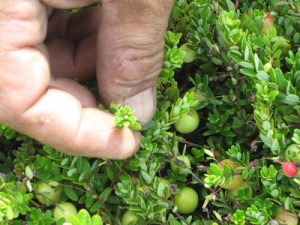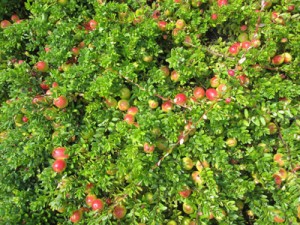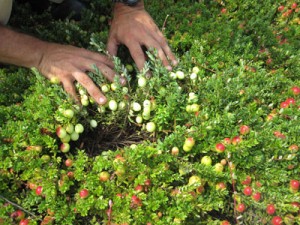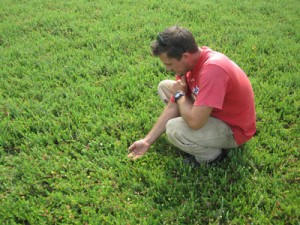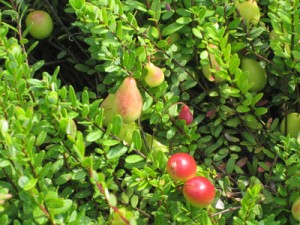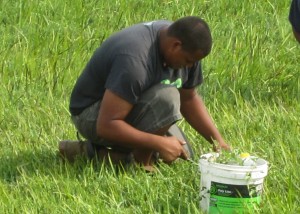As we move into the late summer, we are continuing to implement our PIICM program with late fertilizer applications (or, bud set fertilizer), finishing cleaning the ditches for improved water flow, and maintaining the balancing act of keeping vines cool while avoiding oversaturation. At this time of year, we need to be careful for next year’s bud set (initiation of next year’s flower growth). During bud set, we’re more concerned with keeping the vines healthy; nitrogen is needed for both fruit development and production of the next year’s flower bud.
The berries themselves are beginning to size up and attain color. Some varieties color earlier than others, and that is a factor we consider when planning our picking strategy. Ocean Spray likes a consistent color, so we will take samples to the receiving station to check the TAcy number (an acronym for “total anthocyanin concentration” and is a unit of color measurement used in a cranberry) before harvesting. While the humidity gets worse in late summer, the nights tend to get cooler, and this actually improves the color.
While we’ve talked a lot about the new Rutgers varieties when discussing planting and bog renovation, they are not the only varieties we grow at Pine Island. Many of our bogs still contain the industry stand-bys: Stevens, Early Blacks, and Ben Lear.
The Stevens variety accounts for 20% of the berries grown in New Jersey, according to the Cranberry Marketing Committee. A later variety (meaning they attain their full color later in the season), Stevens are usually the last to be harvested and are thus more susceptible to scald and rot, so we need to monitor bogs such as Roundhouse (one of our Stevens bogs at the northern end of the farm) carefully. Another interesting fact about Stevens: the majority of the crop in a Stevens bog is located under the canopy (or surface) of the vines.
The next stop on our tour was 28 Acre, one of our Early Black producers. Early Blacks are one of the oldest and the smallest varieties, but have the most intense color. (Jeremy Fenstermaker, a Pine Island foreman and harvest supervisor, likes to think that Early Blacks are the berries appearing in most commercials due to their photogenic quality.) When we harvest an Early Black bog we like to see as many berries as possible; the greater the weight, the greater the yield (one barrel = 100 pounds of cranberries).
Ben Lears are an early variety noted for its size and distinctive shape, with a deep red color about midway between Stevens and Early Blacks. We will usually start our harvest with Ben Lear bogs.
Our primary focus as we continue to monitor and scout the bogs is weed control. Dewberry is a very persistent plant that competes with cranberries for light and interferes with harvest, so removing it is a high priority task.
As always, we continuously monitor weather conditions, especially as hurricane season reaches its peak. And, all of our efforts throughout the growing season are bringing us toward our ultimate goal: a successful harvest.

